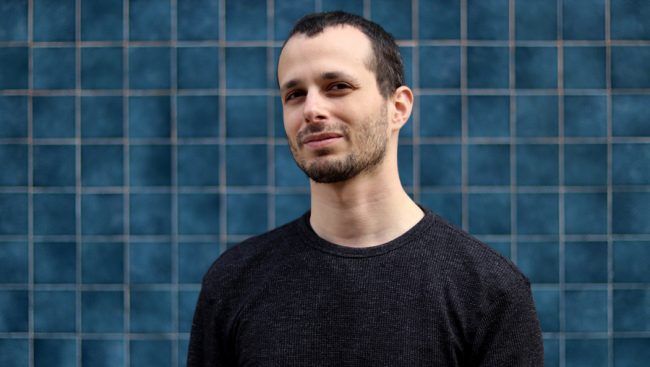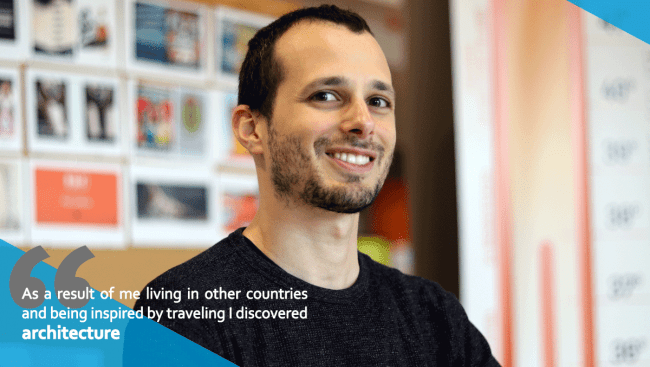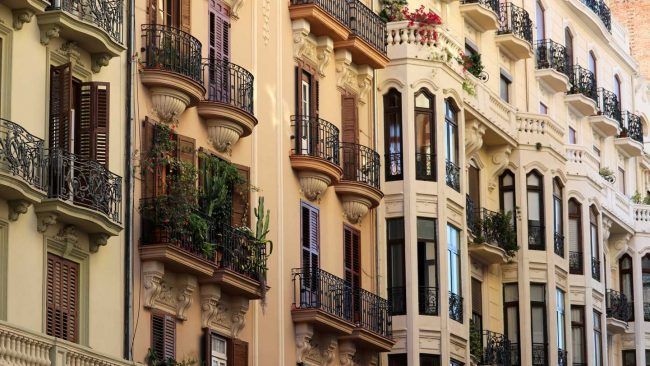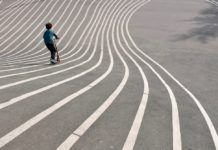If you ever had a conversation with future architects about their passion for architecture, you would probably hear them talking about famous churches or spectacular skyscrapers. However, our first-year student David from the United States has a slightly different and yet very interesting perspective on architecture. He is passionate about urban planning.

Moreover, David already has some ideas of how he could improve the quality of life for the humanity. Through well-thought-out urban planning, of course!
Tell us, David, why did you decide to study Architecture in the first place?
Actually, I’ve studied a couple of different things before. At first, it was International Relations back home in Miami. Later on, I’ve studied Aviation Engineering in Riga (Latvia) for one year. Finally, I switched to Architecture because I want to change the world in a lot of very specific ways. I believe that I will be able to do it only through architecture.
I’ve spent most of my life in a car-dependent city. Luckily, I had an amazing opportunity to live in pedestrian cities including Buenos Aires, Riga and Valencia. The quality of life in those two types of cities is just spectacularly different in so many radical ways. Your daily activities from when you wake up in the morning to when you go to sleep at night are completely ruled by the architecture and the urban planning of the city that you live in. Most people don’t have an awareness of how urban planning affects their lives unless they live in multiple cities at different times and really think about it and notice these things. If not, it looks like it’s naturally how the world is and that’s how it’s supposed to be.
So what’s the change you want to make and how are you going to reach that goal?
Basically, I want to encourage people to go outside and interact with each other. Also, one of the most important things is to find a solution to ecological and economic issues that we have right now. As I said before, we don’t pay attention to small details but it really affects us and our lifestyle.
“One of our biggest challenges is to find a solution to important ecological and economic issues that we are facing now”
For example, in Miami residencies and businesses are kept separated by wide distances. That’s why it’s impossible to walk to anything in Miami. If you want to buy toothpaste, you have to get in a car and drive what leads to both, economic and ecological issues. European cities are designed in such way that it encourages people to go outside and be more aware of the environment. The buildings here are attached to each other, so it’s possible to fit a lot in a much smaller space.
Another important aspect is when you have businesses directly underneath apartments. In this way, there’s more human interaction. I think this is all about little subtle things that create huge differences.
You have lived in many different places. Is traveling one of your sources of inspiration?
Yes, definitely! I realized that I want to redesign the world after living in different cities and exploring the globe. When I was living in Buenos Aires I discovered for the first time how different it is from Miami in terms of pedestrian infrastructure and infrastructure in general and social life as a result. It’s just like night and day. Also, when I came to Europe I was impressed by the abundance of well-planned cities.
I would say as a result of me living in other countries and being inspired by traveling I discovered architecture.
“our daily activities are completely ruled by the architecture and the urban planning of the city we you live in”
In your opinion, what are the current trends in architecture?
Experts know that suburbia is extremely unhealthy, bad for the environment, waste a lot of space and yet it is still the dominant trend. Developers buy a giant attractive land and put a huge dysfunctional suburb on it. The houses cost a huge amount of money and then eventually there’s a housing bubble like it happened in 2006 because people don’t actually want to buy single family homes on the scale that they’re being built. So it’s an economic disaster, too.

Maybe there’s a building in Valencia that attracts your attention?
For me it’s more about neighborhoods than particular buildings. I would say the city centre of Valencia and the area around Ruzafa are my favorites. The buildings there are attached to each other and they are colorful, decorated with beautiful small details. People don’t normally think it could be a tourist attraction but I think it looks really cool and has its own charm!
Since you are interested more into designing functional urban areas, could you tell us which city in the United States would you recommend to visit for its architecture?
In my opinion, the best cities in the US are the New York City, Boston, San Francisco, Chicago, Portland, Seattle, Washington DC, Philadelphia… Also, I really like Savannah! It’s located on the coast of Georgia, right next to the river. In addition, Savannah is a very nice city, it was established in 1733 by England. It’s truly beautiful with its colonial style, many parks and little old shops! It’s definitely very touristy but it has its beauty.

And an architect that you admire?
Right now I’m doing a project about a Norwegian architect Sverre Fehn. He developed buildings in Italy, Belgium and in other more southern places in Europe that reflect the northern design and style. He used some specific materials that create that soft lightning which you could only find in Antarctica.
Also, Sverre Fehn created a special house design where all the so called wet rooms (kitchen and bathroom) are in the center and the rest of the rooms create a circle around the house and divides the space into 8 different rooms. I truly admire the Scandinavian style.
Scandinavian, Spanish or American style. Classical or modern architecture. Innovative or more traditional projects. We like all styles.
Because here at CEU Valencia what we really like is good architecture.


























